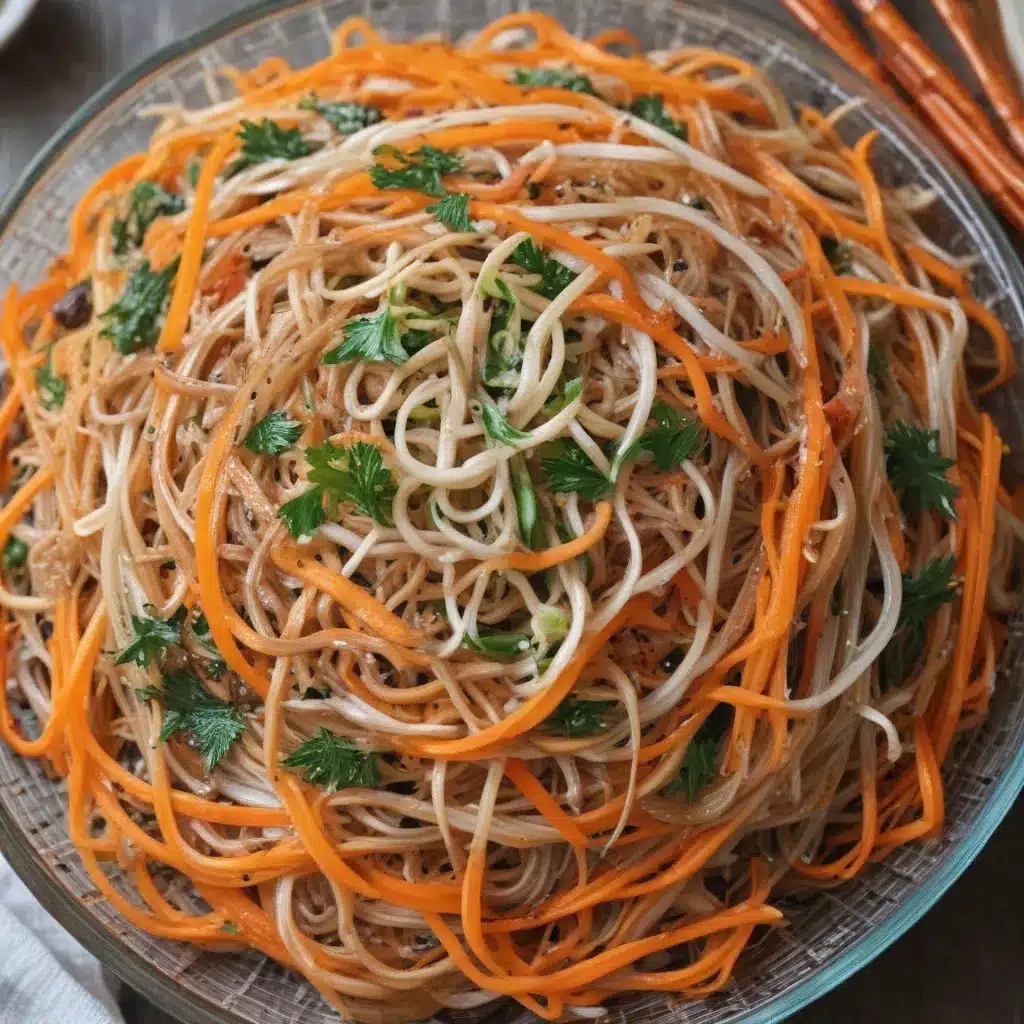
The Humble Origins of Japchae
Ah, Japchae – the beloved Korean dish that has captured the hearts (and taste buds) of foodies around the world. But do you know the fascinating story behind this culinary delight? Allow me to take you on a journey through the rich history and traditions that gave birth to this sweet and savory masterpiece.
Japchae’s origins can be traced back to the Joseon dynasty, a time of great cultural flourishing in Korea. It was during this era that the dish was first recorded in royal court cookbooks, where it was served as a delicacy to the noble classes. The name “Japchae” itself is a testament to the dish’s versatility, as it translates to “mixed vegetables.”
In the early days, Japchae was a simple affair, consisting of sweet potato noodles, sautéed vegetables, and a touch of soy sauce. However, as the dish evolved over the centuries, it gained newfound complexity and depth of flavor. Ingredients like beef, mushrooms, and even pine nuts were gradually incorporated, transforming Japchae into the vibrant and textured dish we know and love today.
The Beauty of Japchae’s Ingredients
But what is it that makes Japchae so special? The secret lies in the carefully selected ingredients that come together to create a symphony of flavors and textures.
Let’s start with the star of the show: the sweet potato noodles, also known as “dangmyeon.” These translucent, glass-like strands are made from sweet potato starch, which gives them a unique chewy and slightly sweet quality. The noodles are not only visually stunning but also incredibly versatile, easily absorbing the flavors of the other ingredients.
Next, the sautéed vegetables. Carrots, spinach, onions, and mushrooms are just a few of the common veggies used in Japchae. Each one adds its own distinct flavor and texture, from the crunch of the carrots to the earthy sweetness of the mushrooms. When combined, they create a vibrant and well-balanced medley that is both visually appealing and absolutely delicious.
And let’s not forget the protein. Thinly sliced beef is a classic addition to Japchae, providing a savory counterpoint to the sweetness of the noodles and vegetables. But for those who prefer a vegetarian or vegan option, tofu or even shredded chicken can make a fantastic substitute.
The Art of Japchae Preparation
Now, the real magic happens in the kitchen. Preparing Japchae is a delicate dance, where each step is crucial in creating the perfect dish.
First, the sweet potato noodles must be boiled to the perfect al dente texture, ensuring they have the right amount of bite and chew. Then, they are seasoned with a flavorful mixture of soy sauce, brown sugar, and sesame oil, which infuses them with a wonderful depth of flavor.
Next, the vegetables are sautéed in a wok or skillet, each one cooked to its optimal tenderness. This requires a keen eye and a deft touch, as the goal is to maintain the vibrant colors and distinct flavors of each ingredient.
Finally, the noodles and sautéed vegetables are combined, and the protein (if using) is added. The entire dish is then tossed together, allowing the flavors to meld and the textures to complement one another.
But the true artistry of Japchae lies in the presentation. The dish is often garnished with toasted sesame seeds, thinly sliced scallions, and a drizzle of sesame oil, creating a visually stunning and appetizing masterpiece.
Japchae: A Versatile Delight
One of the things that makes Japchae so special is its incredible versatility. While the classic version is a true delicacy, the dish can be easily adapted to suit a wide range of tastes and dietary preferences.
For the health-conscious, Japchae can be made with a lighter touch, using less oil and emphasizing the natural flavors of the ingredients. Vegetarians and vegans can swap out the beef for firm tofu or even mushrooms, creating a just as satisfying and flavorful dish.
But the fun doesn’t stop there. Japchae can also be enjoyed as a side dish, complementing a variety of Korean and Asian-inspired main courses. Its sweet and savory profile makes it a perfect pairing for grilled meats, spicy stir-fries, or even a simple bowl of steamed rice.
And let’s not forget the endless possibilities for creativity. Enterprising home cooks and chefs have been known to experiment with Japchae, incorporating unexpected ingredients like edamame, bell peppers, or even a touch of gochujang (Korean chili paste) for a unique twist on the classic.
A Delightful Conclusion
As I sit here, reminiscing about the countless Japchae dishes I’ve savored over the years, I can’t help but feel a deep appreciation for this humble yet extraordinary creation. It’s a dish that has the power to transport you to the heart of Korean culture, with each bite revealing layer upon layer of flavor and history.
So, if you haven’t yet had the pleasure of experiencing Japchae, I urge you to give it a try. Whether you’re a seasoned Korean food enthusiast or a newcomer to the cuisine, this sweet potato glass noodle dish is sure to delight and captivate your taste buds.
And if you’re looking for the best Japchae in Boston, be sure to visit Korean Garden. Their talented chefs have perfected the art of this beloved dish, using only the freshest ingredients and time-honored techniques to create a culinary masterpiece that will leave you craving more.
